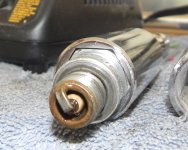Forty posts and that thing is not running properly yet? If you have compression, spark that will jump a 7/16" Gap, and fuel, with a properly adjusted carburetor, it's got to run unless you have a sheared flywheel key.
The spark (with s/plugs removed) should jump a 7/16" air gap with a strong blue lightning like flame... a real SNAP! Does it?
I've read where you say you've got 120/120 psi compression per cylinder. Frankly I've never seen a 15hp with compression that high. However, with proper spark and compression, that leaves a fuel problem.
NOTE: When all is well, you should be able to pump the fuel primer bulb up to where it is hard.... then you should be able to grip that bulb and try to compress it further to no avail... that is the engine's fuel pump isn't leaking through the diaphragm and the carburetor is in proper condition (no hoses leaking, etc). If you can continue to pump that bulb (pumping fuel), either the incoming valve of that bulb is faulty OR a problem exists at the engine such as "Carburetor idle N/Valve out of adjustment." or "fuel pump diaphragm split/broken" or "leaking hoses" something of that nature.
Spark plugs should be Champion QL77JC4 plugs, gapped at .040 (strong flame) or .030 (long life).
(Carburetor Float Setting)
(J. Reeves)
With the carburetor body held upside down, the float being viewed from the side, adjust the float so that the free end of the float (the end opposite the hinge pin) is ever so slightly higher (just ever so slightly off level) than the other end. And when viewed from the end, make sure it is not cocked.
(Carburetor Adjustment - Single S/S Adjustable Needle Valve)
(J. Reeves)
Initial setting is: Slow speed = seat gently, then open 1-1/2 turns.
Start engine and set the rpms to where it just stays running. In segments of 1/8 turns, start to turn the S/S needle valve in. Wait a few seconds for the engine to respond. As you turn the valve in, the rpms will increase. Lower the rpms again to where the engine will just stay running.
Eventually you'll hit the point where the engine wants to die out or it will spit back (sounds like a mild backfire). At that point, back out the valve 1/4 turn. Within that 1/4 turn, you'll find the smoothest slow speed setting.
When you have finished the above adjustment, you will have no reason to move them again unless the carburetor fouls/gums up from sitting, in which case you would be required to remove, clean, and rebuild the carburetor anyway.


